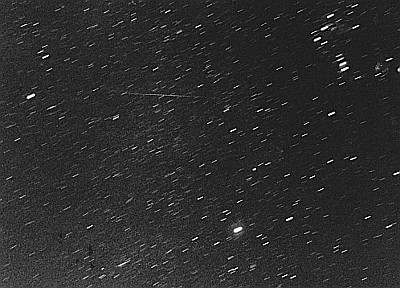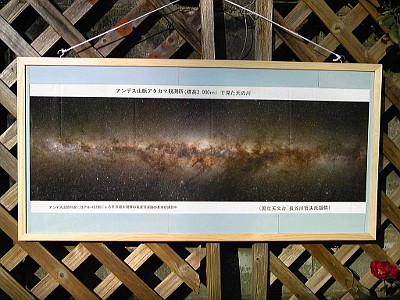November 18, 2009
At 12 midnight on 18th November, the sky began clearing up
miraculously when the Leonid meteor shower was just about to start. At
the observatory, I kept watch from inside the dome and at times outside
while doing other observational work. I think I saw most meteors around
half past 4 in the morning. Twenty to thirty meteors appeared per hour
on the average. Although I set up two cameras and continued to photograph
for nearly 4 hours, I saw few bright fireballs and captured only one first-magnitude
meteor. It reminded me how difficult it was to photograph meteors.
I had been a meteor observer in the 1950s prior to my comet
discoveries. While continuing comet search, I kept in contact with Mr.
Kojiro Komaki, a meteor observer living in Wakayama prefecture, and was
totally immersed in meteor observing. In those days, meteors were observed
mostly visually. I marked the path of each meteor on a specially-made star
chart and reported the results. Later, I began photographic observation,
but with a combination of slow film and poor quality lenses, it would be
a miracle to succeed. Managing to photograph just one meteor this time,
I recalled my struggle in those days. In an astronomy magazine, Mr. Komaki
mentioned three names: Koichi Yoshii, Tetsuma Sakamoto, and me as successful
observers in photographic observation of meteors. Mr. Komaki was a pioneering
figure in Japan's meteor observation and visited me at home in 1962. It
was the year of my discovery of Comet Seki-Lines and I clearly remember
the conversation I had with Mr. Komaki and "astronomy adventurer"
Mr. Koichi Ike that day.

A meteor (Leonid meteor)
At 4:30 November 18, 2009
Asahi Pentax SP with Takumar 24mm f/3.5
ISO 1600 film, fixed-tripod photo
November 7, 2009
Dr. Tetsuo Hasegawa of National Astronomical Observatory
of Japan has sent me a photograph of the magnificent Milky Way over the
Andes. I first met him several years ago at the lectures about the ALMA
project held at Kochi Prefectural Education Center. The ALMA project is
an international collaboration between East Asia (represented by Japan),
North America, and Europe and involves the construction of radio telescopes
in the Andes. Dr. Hasegawa serves as Deputy Project Manager at Joint ALMA
Office in Santiago, Chili. In No. 189 of NAOJ News, he writes that he was
drawn into the world of astronomy by reading my book "Seeking Unknown
Stars" when he was in 5th or 6th grade of elementary school. I had
a similar encounter with an important book when I was in upper grade of
elementary school. The book was "Tenmongaku shinwa" (new astronomy
book) written by Takehiko Matsukuma. which my teacher gave me. This reminds
me of the power of a single book that can influence a person in their developing
stage.
This photograph of the summer Milky Way was taken at the
ALMA Operations Support Facility (elevation 3000 meters) situated on the
side of the Andes. It covers the Milky Way from the Northern Cross of Cygnus
in the north to the far south of the famous Southern Cross, stretching
as long as 110 degrees. It is truly a panoramic view of the Milky Way.
It is said that there are too many stars seen from the Andes that picking
out star patterns for constellations was impossible. Instead, they gave
the names of various animals to many dark nebulae seen at places in the
sky. Come to think of it, the dark nebula known as the Coal Sack is seen
near the Southern Cross opening a dark eerie gaping mouth. And the splendid
site of the Jewel Box is impressive making a striking contrast with the
dark nebulae.
In 2000, standing at the summit of Mauna Kea, I was overwhelmed
by the awesome starry skies. I wonder if I can ever have a chance to see
the starry skies over the Andes.
I will make a frame for this photograph and display it at
Geisei Observatory.


